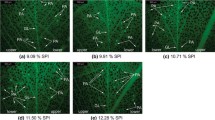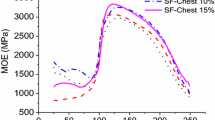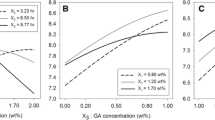Abstract
Wetting of soy protein adhesives modified by urea on wood surfaces was investigated with sessile liquid droplet method. Dynamic contact angles were used to illustrate the wetting process. The effects of wood surface roughness and urea concentration on contact angles were investigated. Moreover, two wetting models were used to describe the dynamic contact angle process, in which the contact angle change rate constant (K) can be used to quantify the adhesive spreading and penetration during the wetting process. The results showed that the wetting models could accurately describe the dynamic wetting process of soy protein adhesives on wood surfaces.
Zusammenfassung
Der Auftrag von mit Harnstoff modifiziertem Sojaproteinklebstoff auf Holzoberflächen wurde mit dem Verfahren des „ruhenden Tropfens“ (Sessile-Drop-Verfahren) untersucht. Der Benetzungsverlauf wurde mittels dynamischer Kontaktwinkelmessung aufgezeigt. Die Einflüsse der Oberflächenrauhigkeit des Holzes sowie der Harnstoffkonzentration auf die Kontaktwinkel wurden untersucht. Anhand zweier Benetzungsmodelle wurde der dynamische Kontaktwinkelverlauf beschrieben, wobei die Konstante (K) der Funktion der Kontaktwinkeländerung zur Bestimmung der Klebstoffverteilung und der Eindringung in das Holz während der Benetzung verwendet wird. Die Ergebnisse zeigten, dass mit den Benetzungsmodellen der dynamische Benetzungsprozess von Sojaproteinklebstoff auf Holzoberflächen zutreffend dargestellt werden kann.








Similar content being viewed by others
References
Chen CM (1972) Measuring the wetting of wood surfaces by adhesives. Mokuzai Gakkaishi 18(9):451–456
Cheng E, Sun X (2006) Effects of wood-surface roughness, adhesive viscosity and processing pressure on adhesion strength of protein adhesive. J Adhes Sci Technol 20:997–1017
Huang W, Sun XS (2000a) Adhesive properties of soy proteins modified by urea and guanidine hydrochloride. J Am Oil Chem Soc 77(1):101–104
Huang W, Sun XS (2000b) Adhesive properties of soy proteins modified by sodium dodecyl sulfate and sodium dodecylbenzene sulfonate. J Am Oil Chem Soc 77(7):705–708
Kalapathy U, Hettiarachchy NS, Myers D, MA Hanna (1995) Modification of soy proteins and their adhesive properties on woods. J Am Oil Chem Soc 72(5):507–510
Kalapathy U, Hettiarachchy NS, Myers D, Rhee KC (1996) Alkali-modified soy proteins: effect of salts and disulfide bond cleavage on adhesion and viscosity. J Am Oil Chem Soc 73:1063–1066
Kumar R, Choudhary V, Mishra S, Varma IK, Mattiason B (2002) Adhesives and plastics based on soy protein products. Ind Crop Prod 16(3):155–172
Kumar R, Choudhary V, Mishra S, Varma IK (2004) Enzymatically-modified soy protein part 2: adhesion behaviour. J Adhes Sci Technol 18:261–273
Liu Y, Li K (2002) Chemical modification of soy protein for wood adhesives. Macromol Rapid Commun 23:739–742
Liu Y, Li K (2004) Modification of soy protein for wood adhesives using mussel protein as a model: the influence of a mercapto group. Macromol Rapid Commun 25:1835–1838
Liu FP, Gardner JD, Wolcott MP (1995) A model for the description of polymer surface dynamic behavior. Contact angle vs. polymer surface properties. Langmuir 11:2674–2681
Pizzi A (2006) Recent developments in eco-efficient bio-based adhesives for wood bonding: opportunities and issues. J Adhes Sci Technol 20:829–846
Scheikl M, Dunky M (1998) Measurement of dynamic and static angles on wood for the determination of its surface tension and the penetration of liquids into the wood surface. Holzforschung 52:89–94
Shi SQ, Gardner DJ (2001) Dynamic adhesive wettability of wood. Wood Fiber Sci 33:58–68
Stehr M, Gardner DJ, Walinder MEP (2001) Dynamic wettability of different machined wood surfaces. J Adhes 76:185–200
Sun SX, Bian K (1999) Shear strength and water resistance of modified soy protein adhesives. J Am Oil Chem Soc 76:977–980
Zhang Z, Hua Y (2007) Urea-modified soy globulin proteins (7S and 11S): Effect of wettability and secondary structure on adhesion. J Am Oil Chem Soc 84:853–857
Zhong Z, Sun XS, Wang D (2007) Isoelectric pH of polyamide-epichlorohydrin modified soy protein improved water resistance and adhesion properties. J Appl Polym Sci 103(4):2261–2270
Zhou ZB, Hou ZB, Zhang Y, Jia C (2007) Describing on dynamic wettability of wood and wood-based materials. J Nanjing For Univ (Nat Sci Ed) 31(5):71–74
Acknowledgements
The study was financed by the International Cooperation Fund from Zhejiang Science and Technology Department (No. 2010C34007).
Author information
Authors and Affiliations
Corresponding author
Rights and permissions
About this article
Cite this article
Xu, HN., Shen, QY., Ouyang, XK. et al. Wetting of soy protein adhesives modified by urea on wood surfaces. Eur. J. Wood Prod. 70, 11–16 (2012). https://doi.org/10.1007/s00107-010-0502-2
Received:
Published:
Issue Date:
DOI: https://doi.org/10.1007/s00107-010-0502-2




